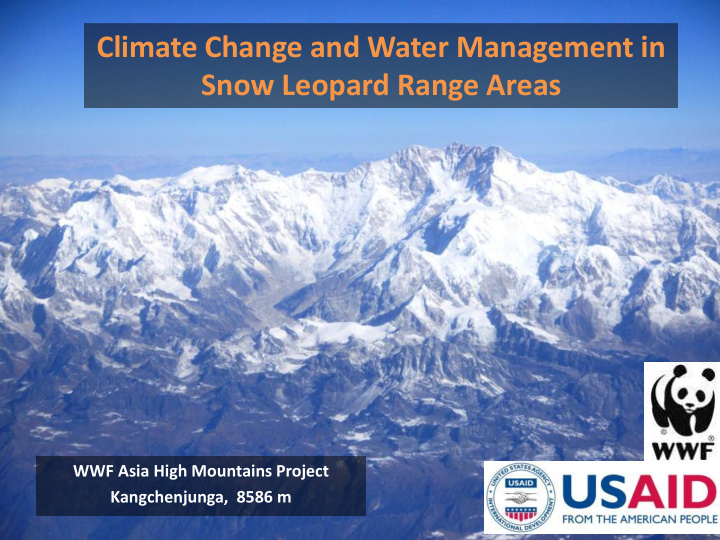



Climate Change and Water Management in Snow Leopard Range Areas WWF Asia High Mountains Project Kangchenjunga, 8586 m
Snow Leopards Snow Leopards live in the high mountains of: Afghanistan Bhutan China India Kazakhstan Kyrgyzstan Mongolia Nepal Pakistan Russia Tajikistan Uzbekistan
Snow Leopards endangered with a total population of about 4000 to 7000 individuals
Snow Leopards Snow Leopards are solitary and primarily prey on Blue Sheep, Ibex, and Argali that Blue Sheep, Nepal inhabit alpine grasslands
Snow Leopards Apex Predator of Asia’s Alpine Ecosystems and therefore are an Umbrella Species for the protection of these ecosystems
Snow Leopards have large home ranges that overlap international boundaries.
Snow Leopards live in the headwaters of Asia’s Great Rivers, including the Yellow, Yangtze, Mekong, Salween, Brahmaputra, Ganges, Amu Darya, and Syr Darya Upper Brahmaputra Tibetan Plateau
Snow Leopards Threats include • Retaliatory Killing by Livestock Herders • Human Encroachment • Climate Change
Some Climate Change Impacts on Snow Leopard Range Areas • Rising Temperatures • Melting of Glaciers • Melting of Permafrost • More Erratic Precipitation • More Extreme Weather Events • Disappearance of Surface Springs and Streams • Degradation of Alpine Grasslands • Declining Water, Food, and Livelihood Security • Increased Potential Human Threats to Wildlife
Map of <-Permafrost Zones in Central Asia Map of Snow Leopard-> Range
Some WWF Water and Climate Adaptation Actions in Snow Leopard Range Areas Ghunsa Village, 3420m Kangchenjunga Conservation Area, Nepal
Bhutan Gangkhar Puensum, 7570m
Model Climate Smart Village Shawa Village, 2280m Lhuntse Province
Solar-Powered Electric Fence Shawa Village, Lhuntse Province
India Khangchendzonga Biosphere Reserve Sikkim
Sustainable Cordyceps Harvesting Lachen Village, 2700m Sikkim
Sustainable Cordyceps Harvesting Brochure
Kyrgyzstan Terskey Ala-Too, Issyk Kul Province
Drip Irrigation Kyzyl Suu Village, Issyk Kul Province
Mongolia Ibex Sair Mountain, 3955m Bayan Olgii Aimag
Sair Mountain Local Protected Area
Nepal Kangchenjunga, 8586 m
High Altitude Greenhouses Ollanchung Gola Village, 3180m Kangchenjunga Conservation Area
Cardamom Irrigation Tapethok Village, 1430m Kangchenjunga Conservation Area
Cardamom Sprinkler Irrigation
Pakistan Meir Glacier, Gilgit-Baltistan
Alfalfa Fodder Crop Planting Hoper Valley, Gilgit-Baltistan
Tree Planting Hoper Valley, 2770m Gilgit-Baltistan
Participatory Watershed Management Planning The WWF Asia High Mountains Project has also launched participatory watershed Management Planning Processes at Project Sites in: • Bhutan • Kyrgyzstan • Mongolia • Nepal • Pakistan Nikka Chu River, Wangchuck Centennial Park, Bhutan
Global Snow Leopard and Ecosystem Protection (GSLEP) Program • Launched in 2013 • 12 Member States • Funding Partners: WWF, SLT, UNDP, GEF • Goal: Protect 20 Snow Leopard Landscapes by 2020 • Strategy: Develop and Implement 20 Climate-smart Snow Leopard Landscape Management Plans • GSLEP is opening a dialogue on shared environmental issues among the 12 member states
President Atambayev, Kyrgyzstan
Prime Prime Minister Dahal, Nepal
UN General Secretary Guterres
Conclusions • Climate change impacts are leading to declines in the water, food, and livelihood security of mountain peoples. • These impacts are only expected to worsen in coming decades , increasing threats to Snow Leopards and downstream water resources. • These high mountain regions are also being rapidly developed . Still, critical data gaps in climate and hydrology. CHARIS is making inroads on filling some of these. • WWF is helping communities adapt through innovative interventions that benefit both people and local ecosystems - improving water, food, and livelihood security in the process.
Conclusions • Through the GSLEP, WWF is supporting snow leopard range states to develop and implement landscape management plans that integrate conservation, development, and climate risks. • CHARIS and the WWF AHM Project have shown that snow leopard habitat provides vital ecosystem services for millions well beyond the remote mountain peaks of high Asia. • We hope to make a contribution to improving water security for millions downstream who depend directly on mountain rivers for their livelihoods and economic well- being. • Still, more effort is needed to demonstrate how upstream conservation can best benefit lowland peoples.
WWF Asia High Mountains Project www.worldwildlife.org/initiatives/asia-high-mountains Akshyrak Village, 3150m, Issyk Kul Province, Kyrgyzstan
Khan Tengri, Kyrgyzstan, 6995m Photo by Pavel Van-Yu-Tsai
Recommend
More recommend